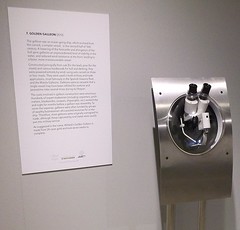 If there is one thing this blog celebrates, it's workmanship. I don't care what I'm looking at, if it's really well made then I can appreciate it.
If there is one thing this blog celebrates, it's workmanship. I don't care what I'm looking at, if it's really well made then I can appreciate it. So, when I received an e-mail from the Library of Birmingham a few days ago promoting a show by the artist Willard Wigan, I was straight to my calendar to see when I should book my ticket.
Willard Wigan specialises in miniature sculptures. When I say miniature, I mean tiny in a way that us normal(ish) model makers will be blown away by. Most of the exhibits in this show are displayed in the eyes of sewing needles.
Normal ones too - not those whopping darning types or the sort used to make carpets. No cheating here.
If the sculpture isn't in a needle, it's on the head of a pin.
 Obviously this is all pretty hard to show so the gallery displays each piece in a bubble containing high power LED lighting and topped with microscope eyepieces.
Obviously this is all pretty hard to show so the gallery displays each piece in a bubble containing high power LED lighting and topped with microscope eyepieces. This means you can try to squint and see the model in normal size or peer through the eyepieces for a proper view. It's quite odd walking around a gallery with hardly any pictures on the wall but things to peer in to instead.
To help understand the work, a video of Willard's TED talk is on show. Best of all though, while I visited, the man himself was around and very happy to answer questions. Although not a permanent fixture in the gallery, I understand he's been there quite a lot. The school party visiting just after I got in certainly appreciated being able to talk to a real artist.
The techniques involved in all of this fascinate me. Carving takes place using a pin sharpened to a knife blade. All work takes place under a microscope and requires the artist to hold his breath (inhaling the piece is easy apparently) and carve between heartbeats. And I thought soldering tiny bits of etched brass is fiddly!
Painting is carried out with hairs from either the artists face or dead flies. I asked about paint and it seems he crushes the pigment using a ball bearing on a microscope slide, under the microscope itself so the pigment is fine enough to work. Rather more effort than opening a tin of Humbrol enamel.
One area where there is a saving of course, is the materials. Many are made from Kevlar or nylon clothing tags. My favourite, a 3-mast galleon on a pin head, is constructed from gold, including the rigging but it's not like much of this precious metal was used up. Normally, Willard uses money spider web for rigging but it was too coarse for this model.
Other highlights as the Last Supper, with all the figures, in a needle, Usain Bolt and a tiny recreation of Leonardo da Vinci's "The Hands" painting. The hummingbird above is worth a look too. Each piece takes at least 6 weeks of 18 hour days to produce.
All this is incredible and needs to be seen to be believed. If you are within striking distance of Birmingham before 25th January, get yourself a ticket and go to see for yourself. Tickets are issued to regulate visitors as too many at once can make it difficutl for everyone to get a proper look at each exhibit - you have to view these 1 to 1!
It's also worth visiting Willard Wigan's website for more photos.
3 comments:
I feel wow kinda understates it!
Not sure about no breathing in in case you swallow the model? Although I once did breath in and get a mouth of woodland scenic grass lol. Thanks for covering this, wonderful work.
With most of the figures being smaller than a lump of Woodland Scenics coarse turf, breathing them in is a real possibility. How anoying would that be?
Post a Comment